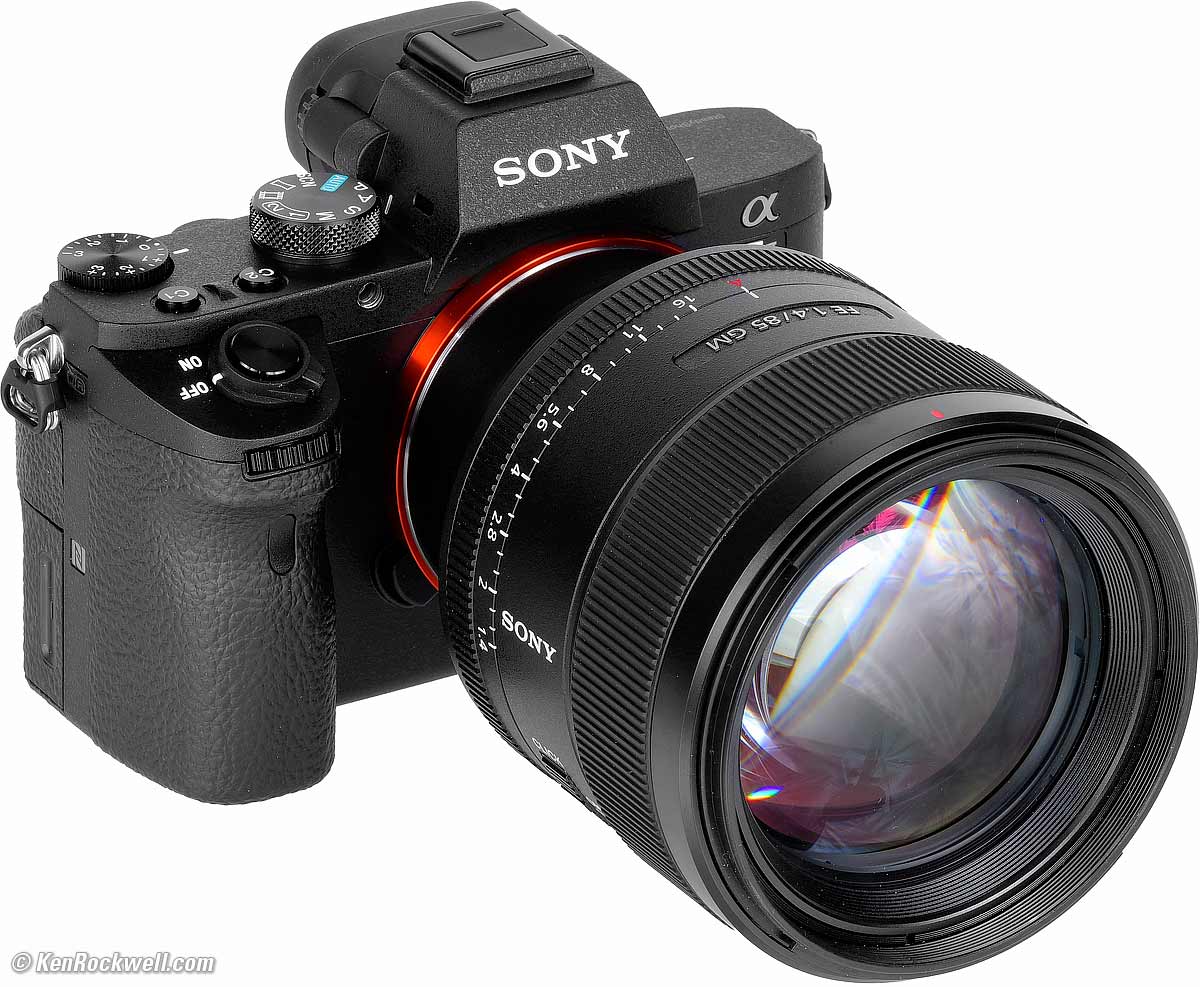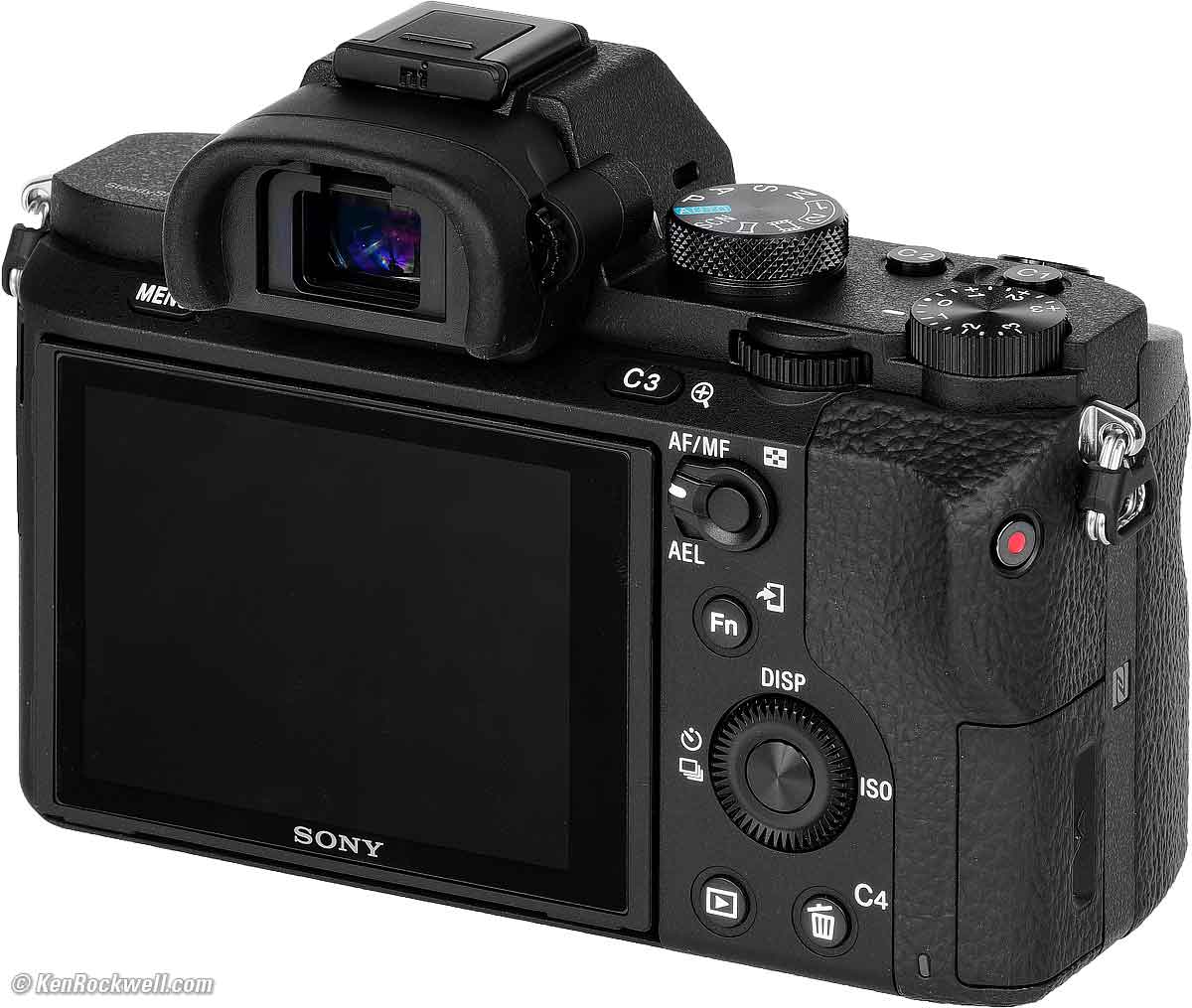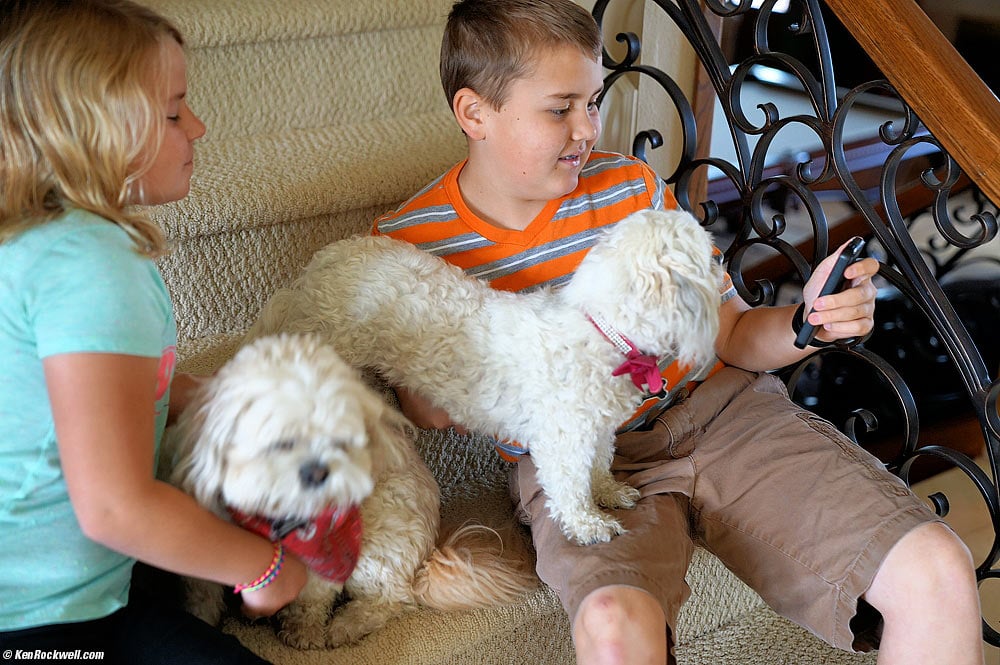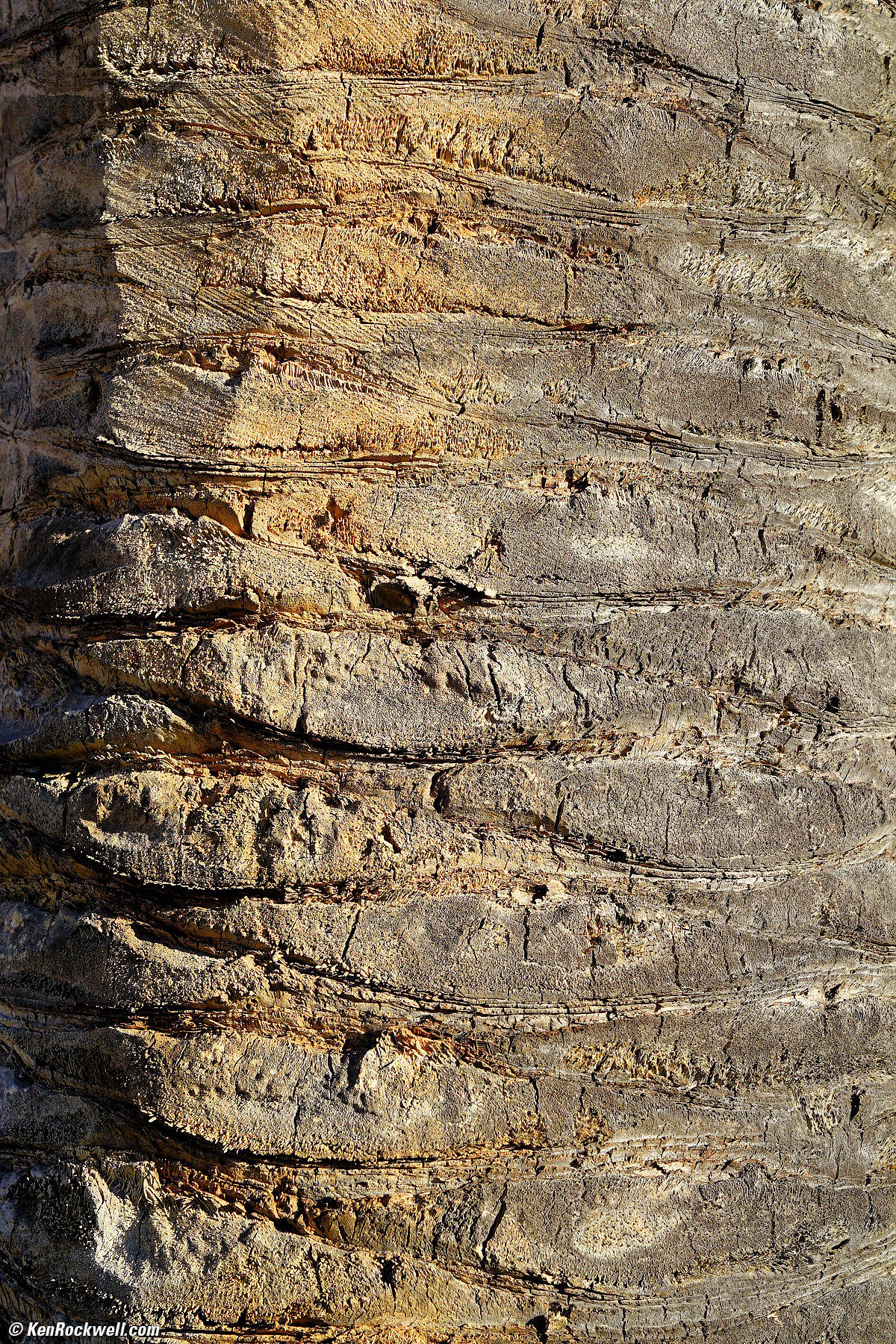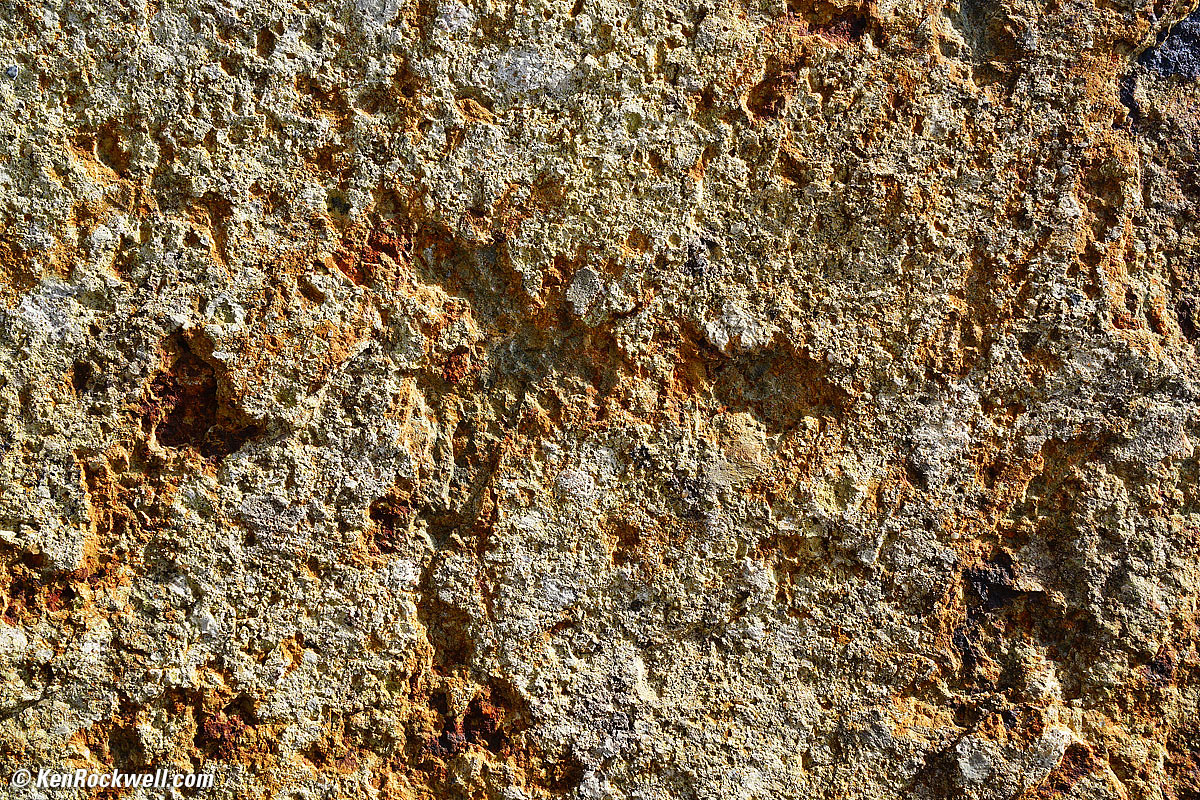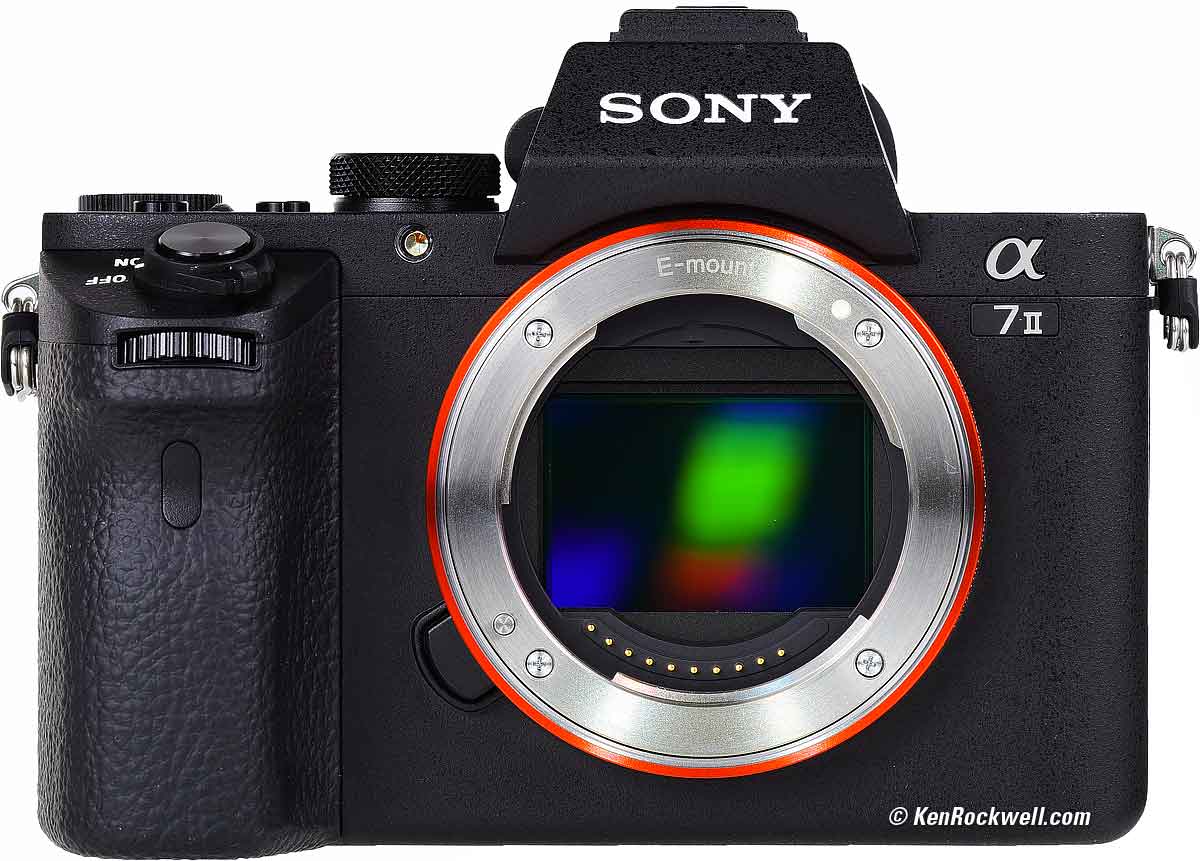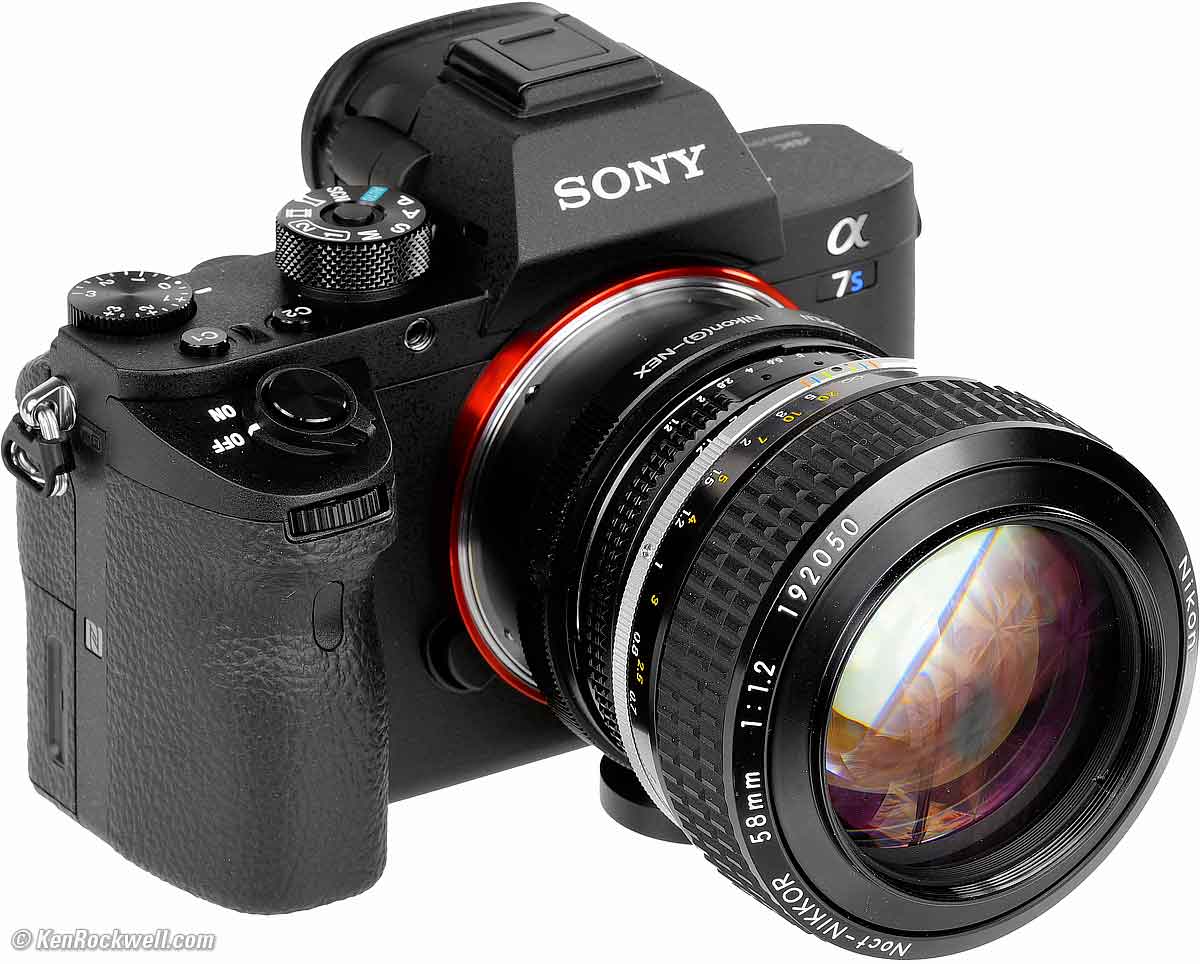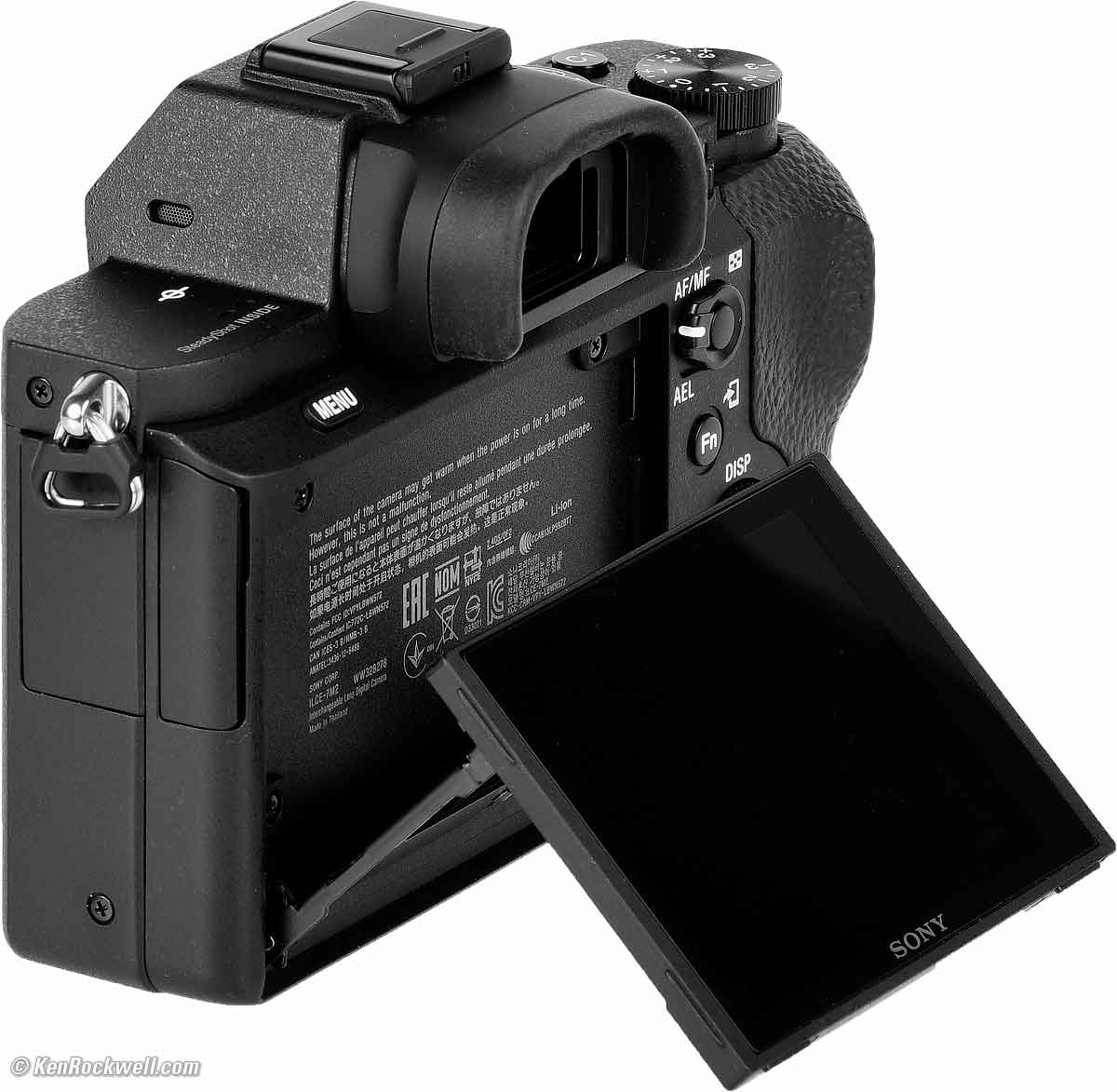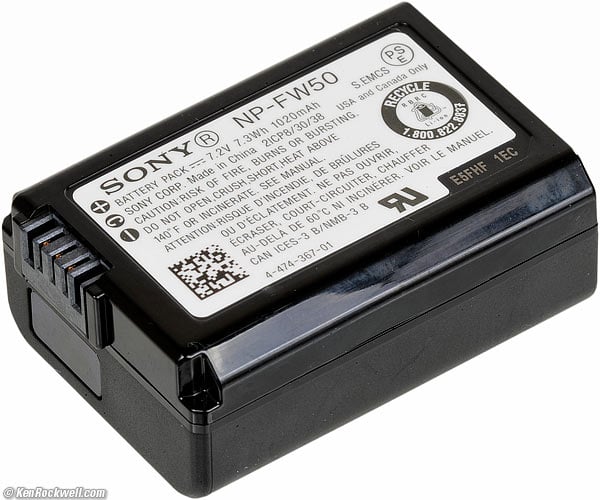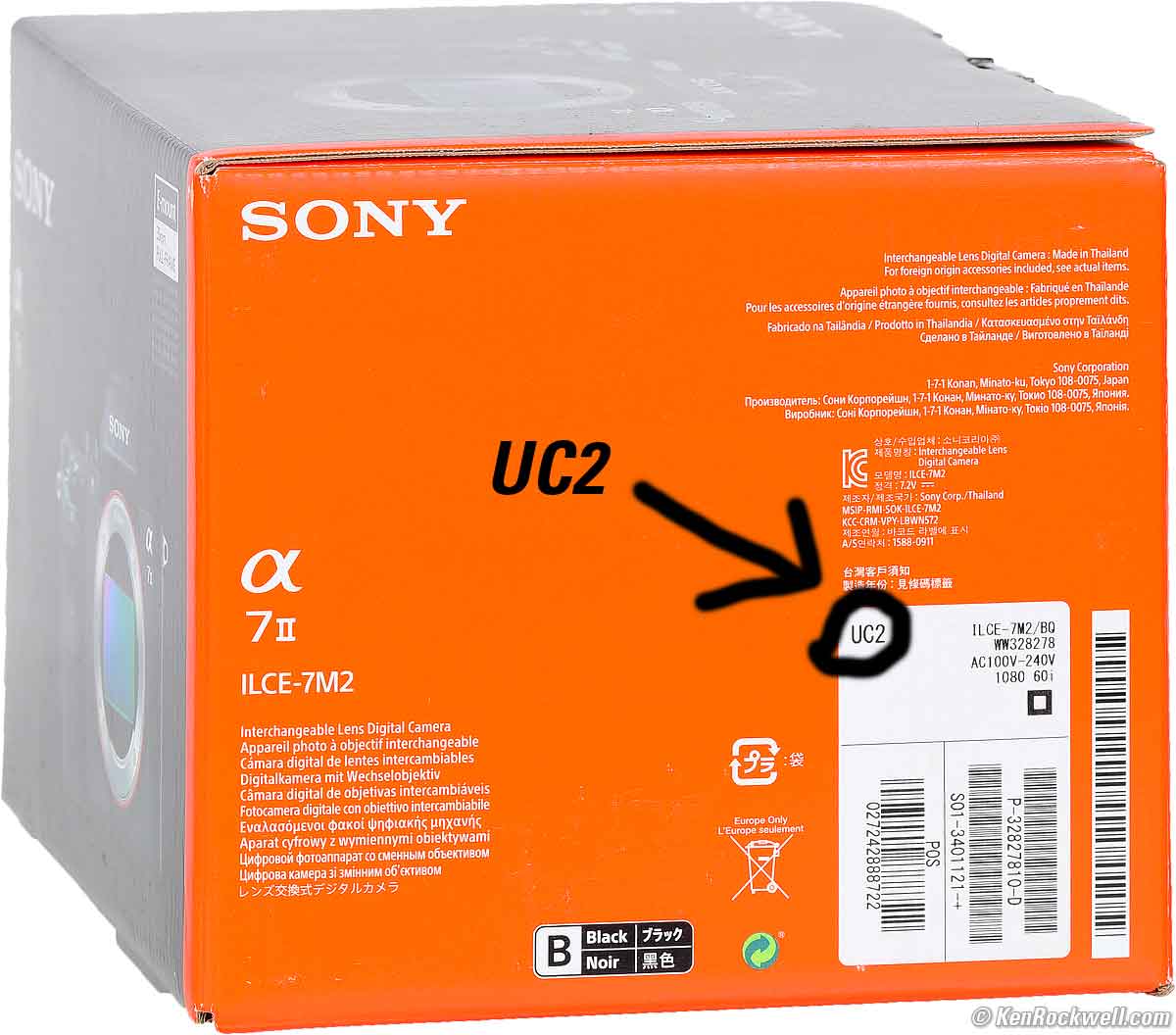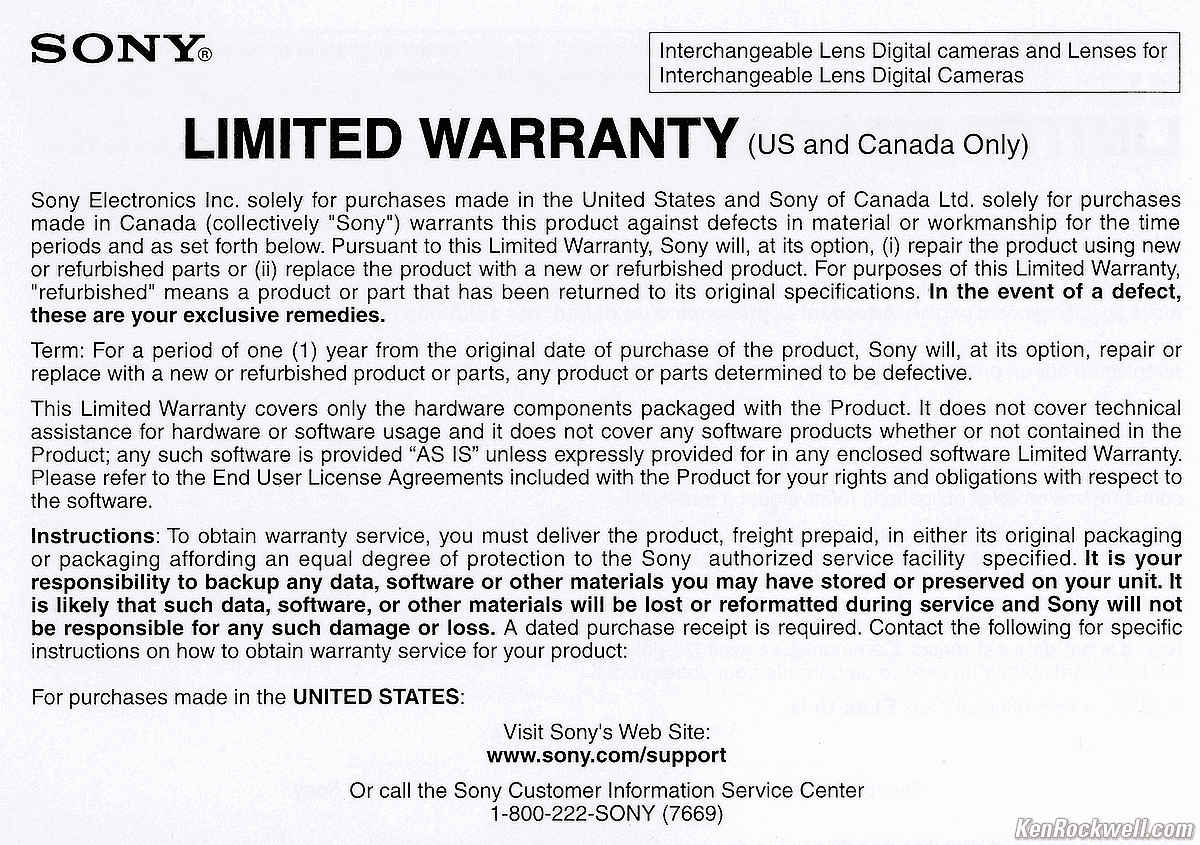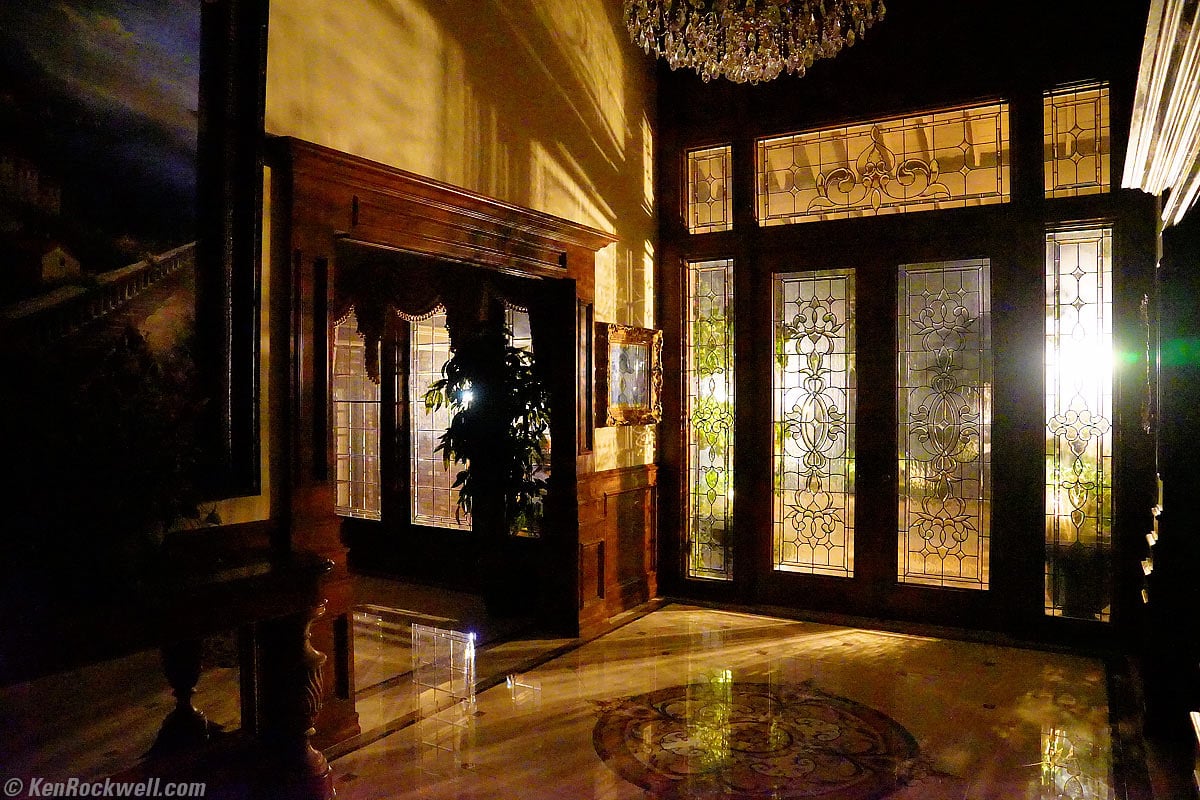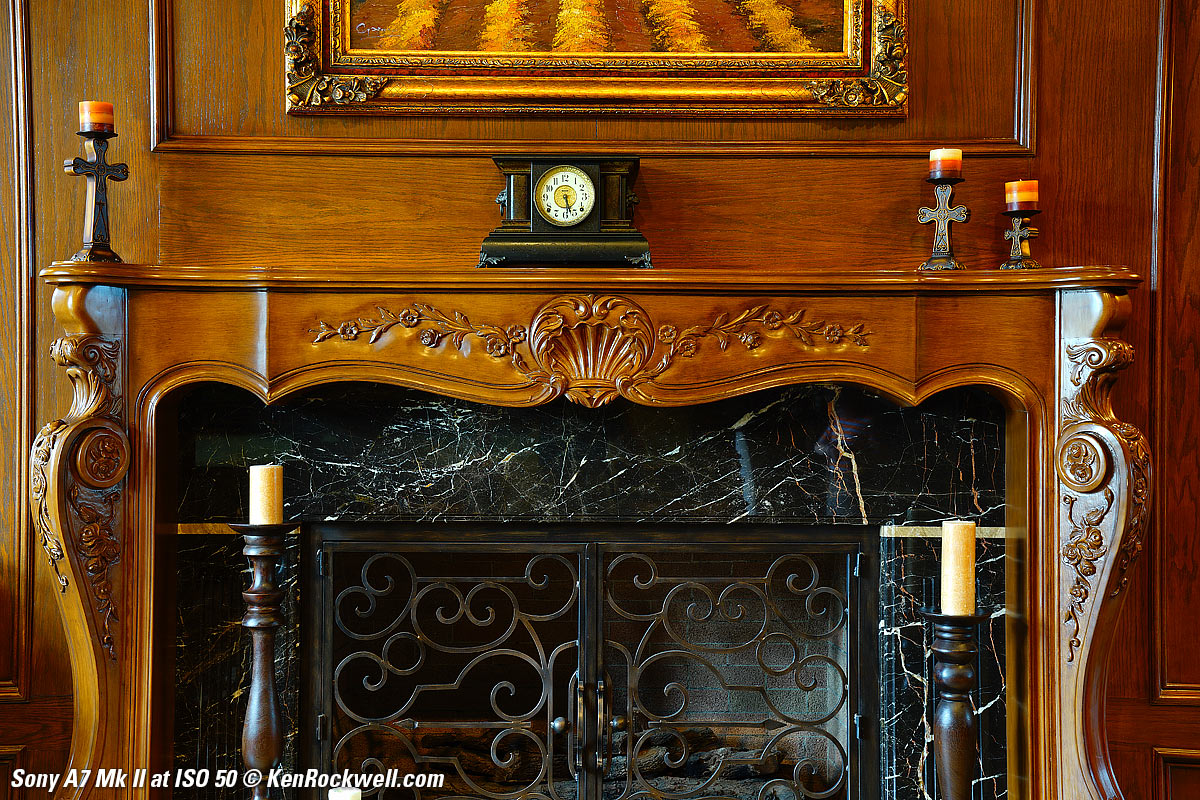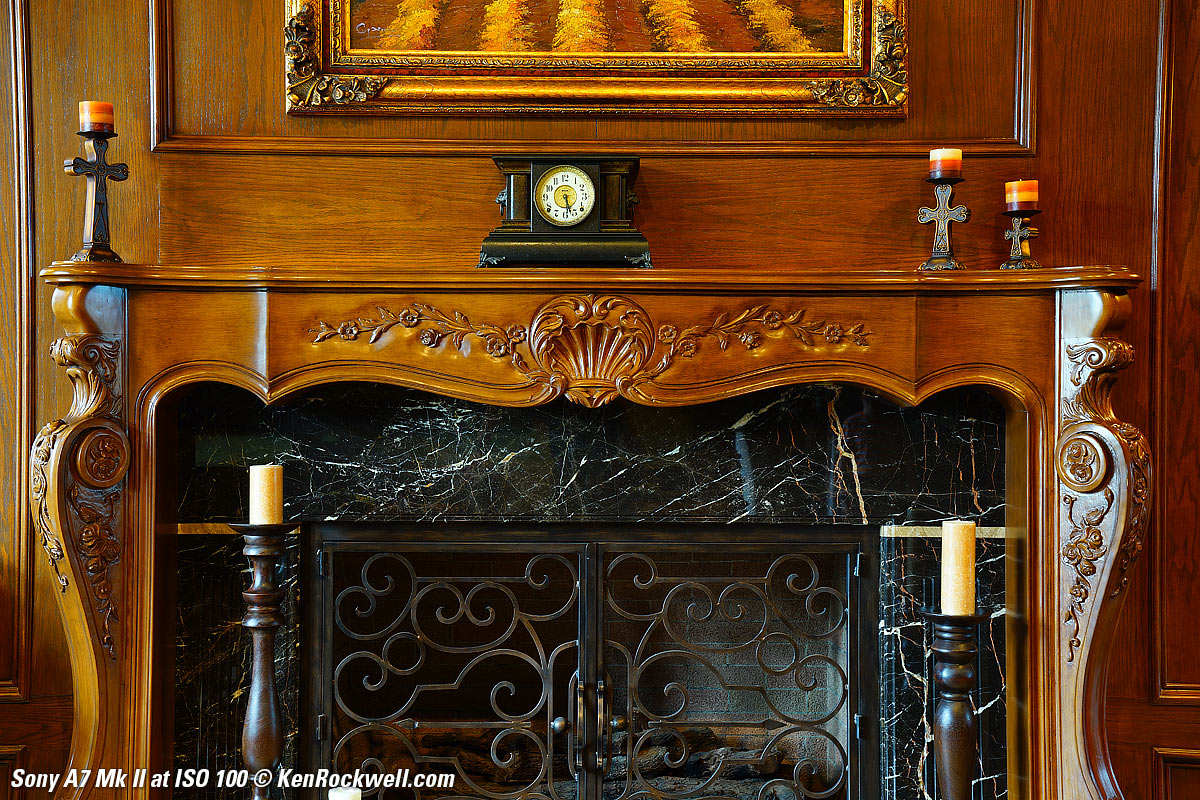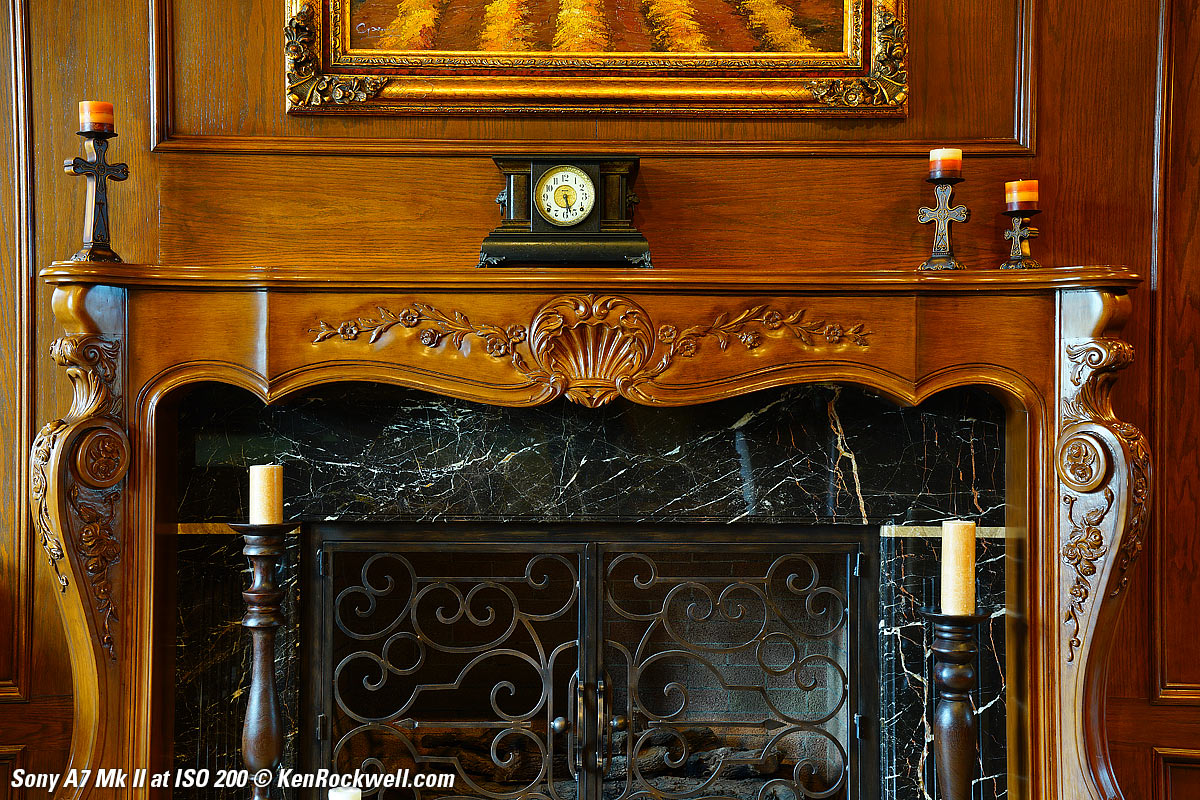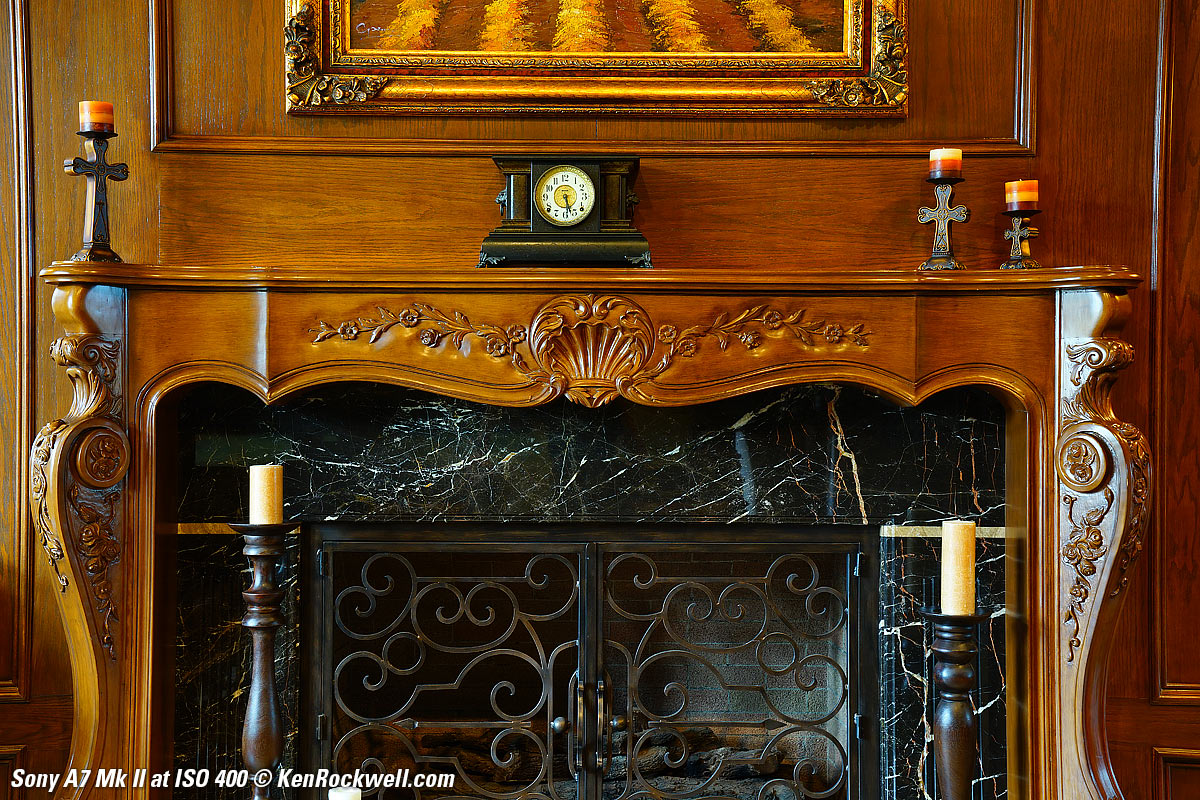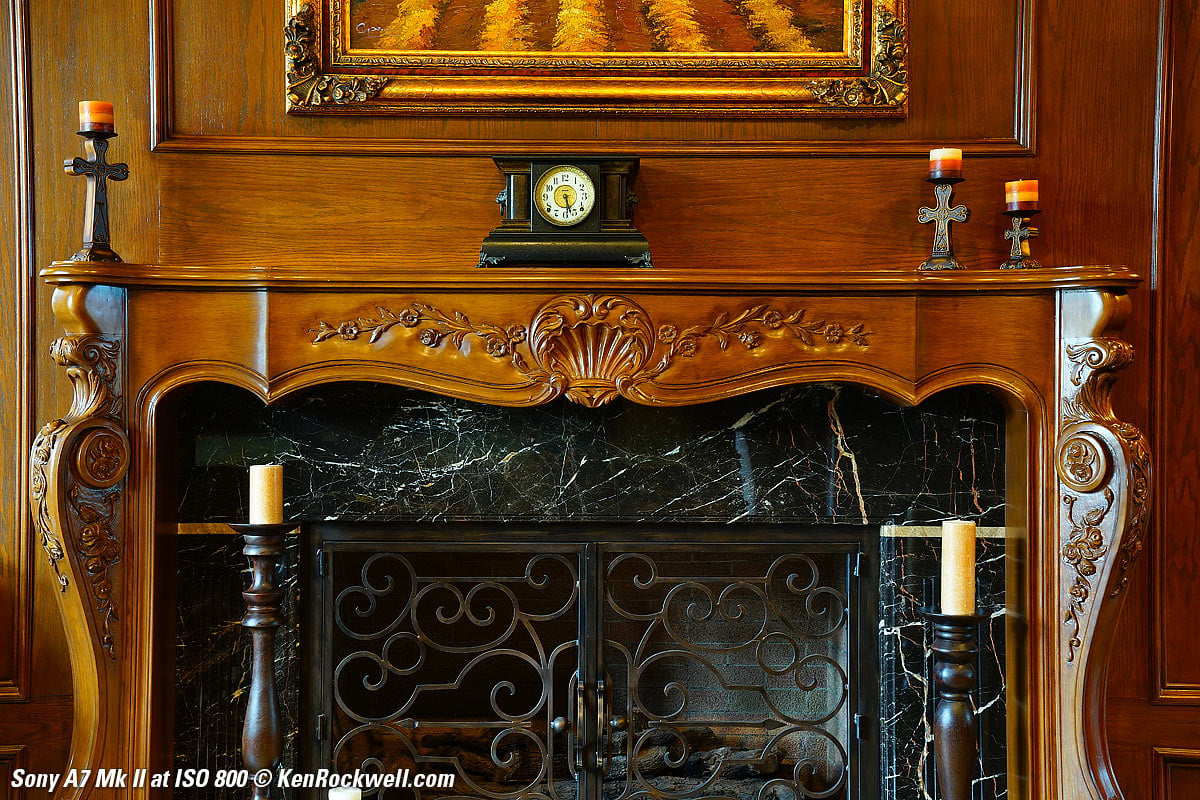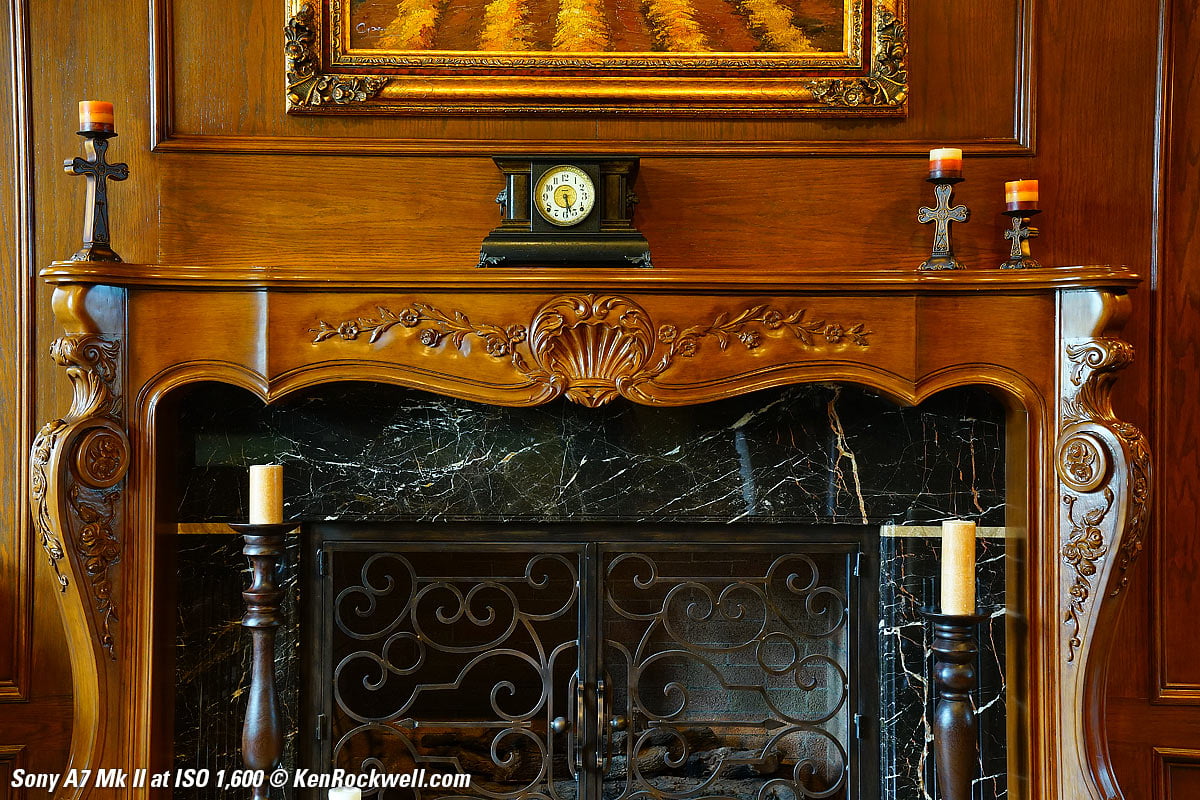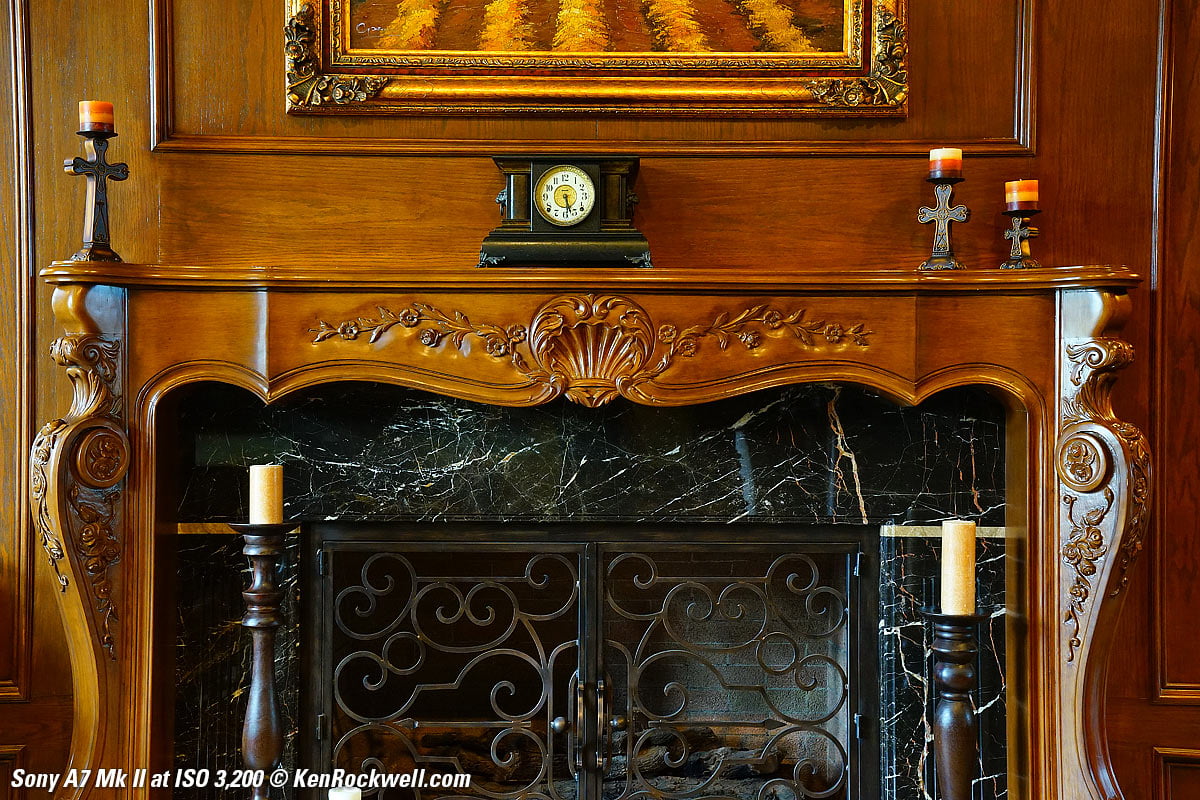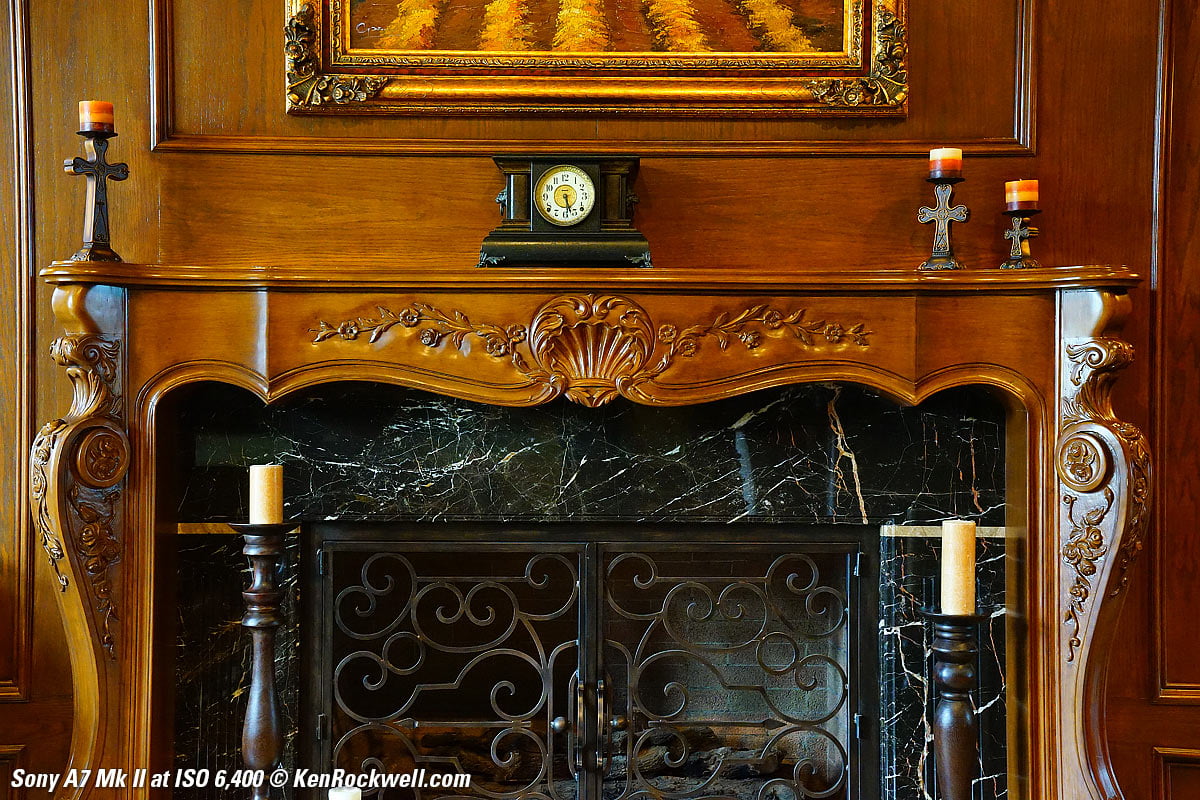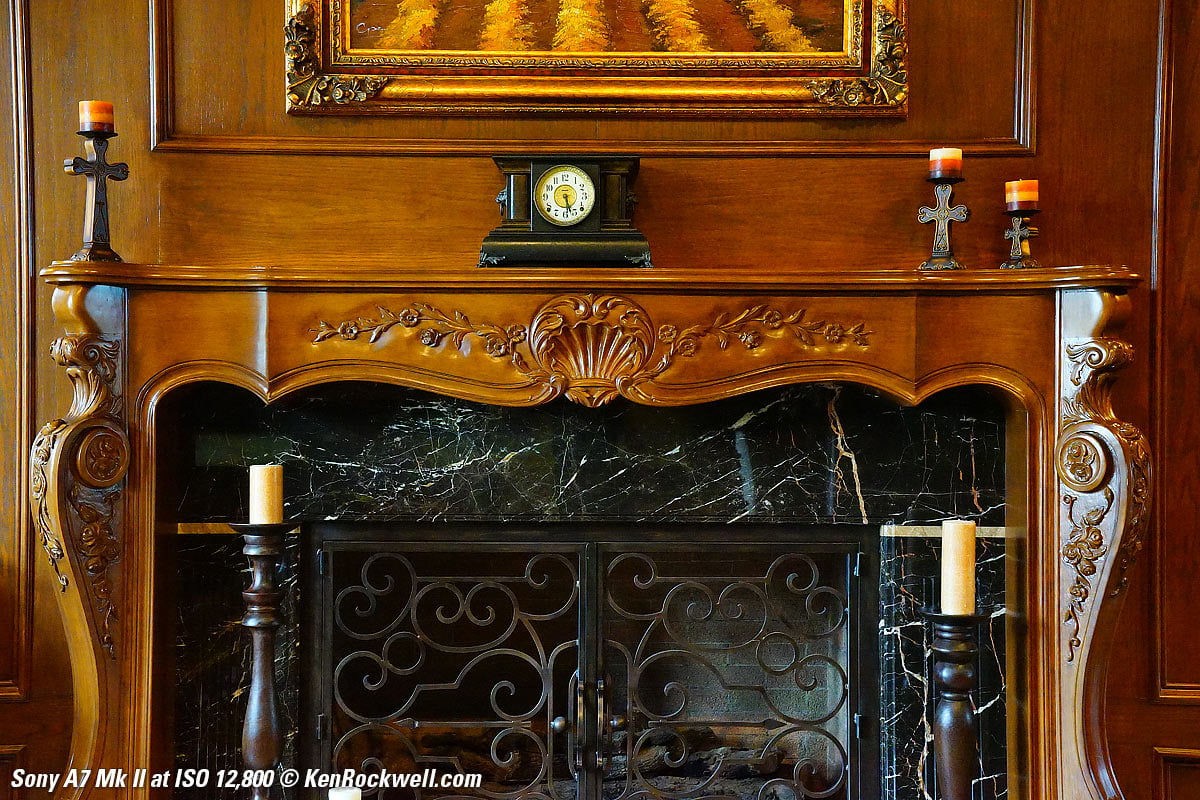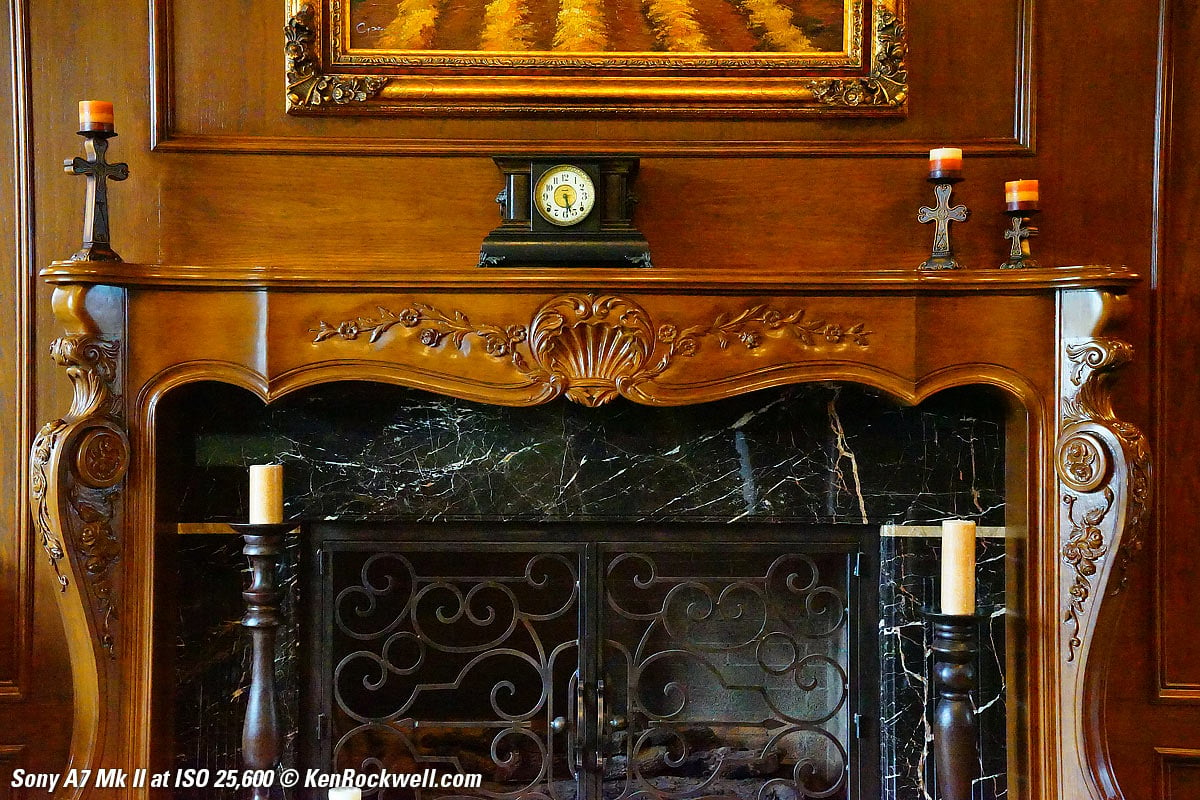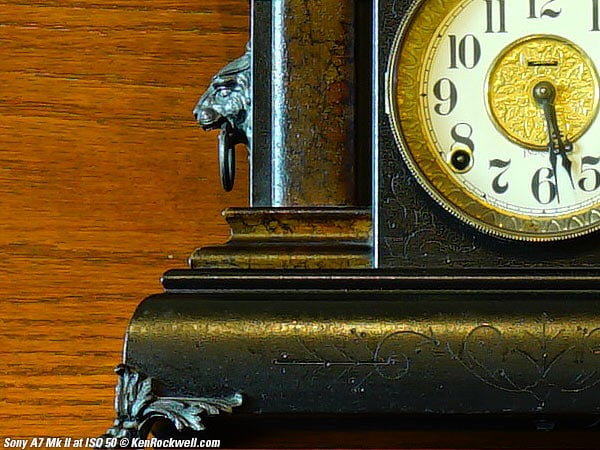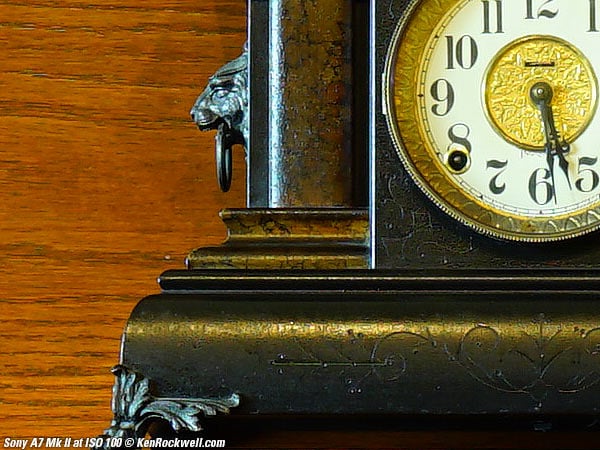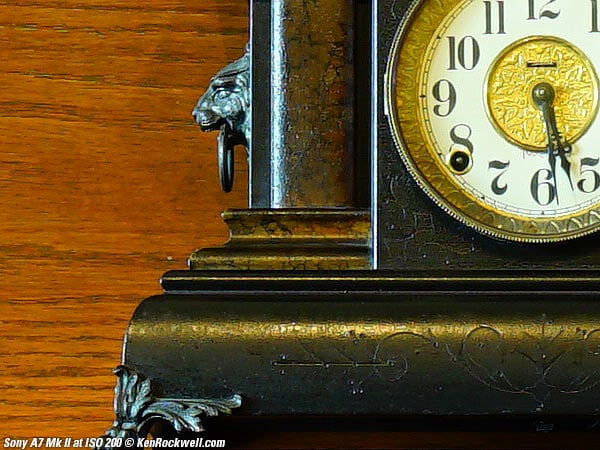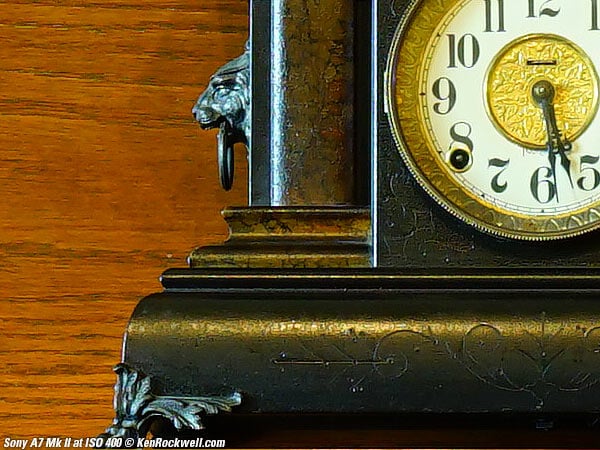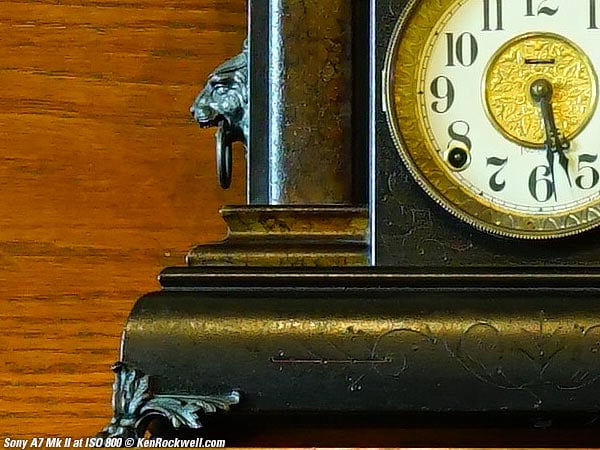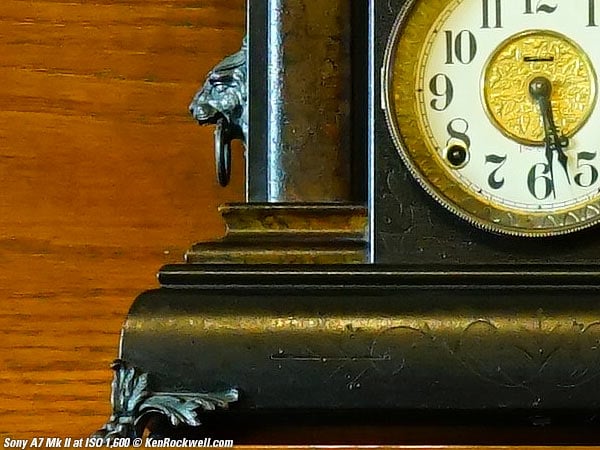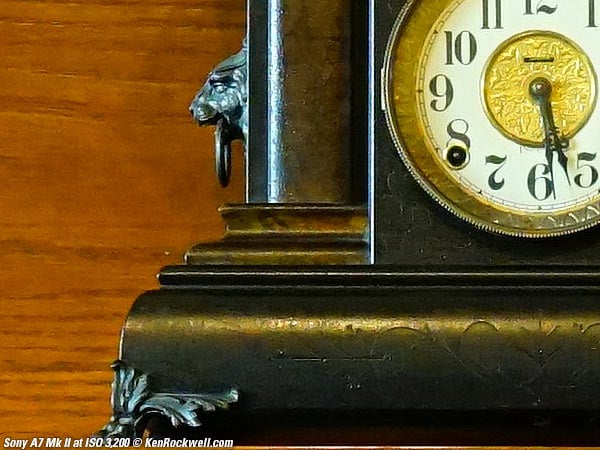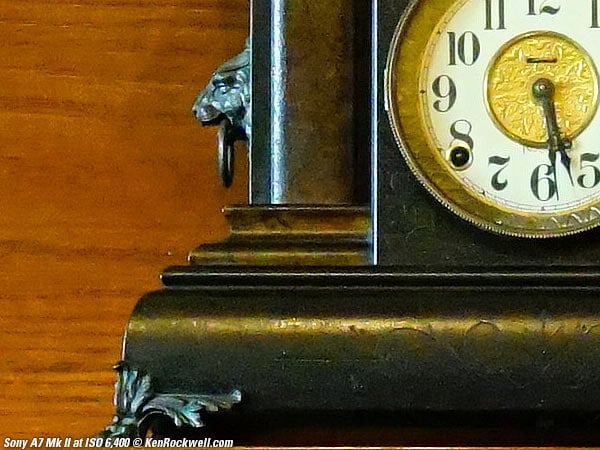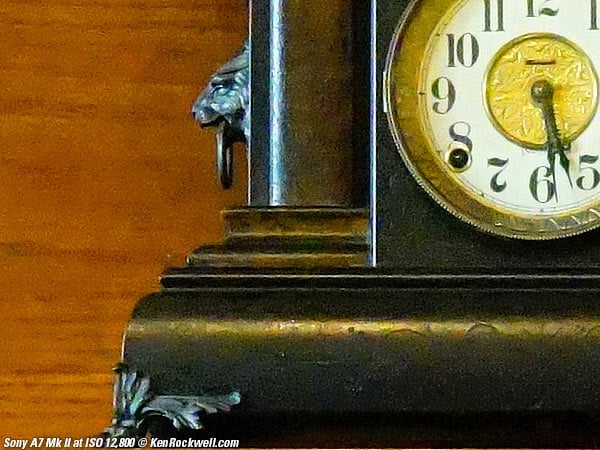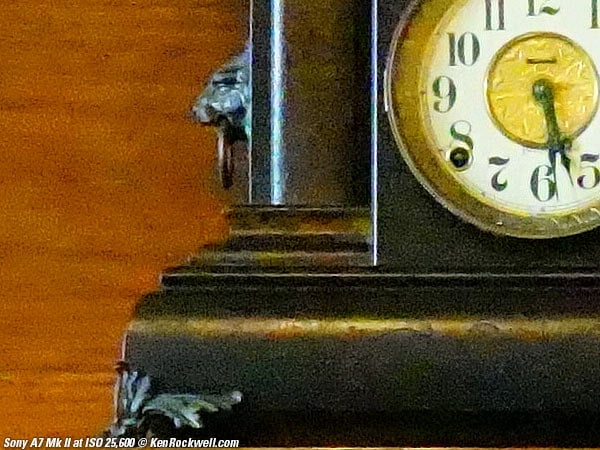Sony A7 Mk II
24MP stabilized full-frame, 5 FPS, ISO 25,600, 1080p Stereo
Top Sample Images Intro Lenses & Adapters
Specifications USA Version Performance
Compared Usage Recommendations More
Sony: A9 III A1 A9 II A9 A7R V A7R IV A7R III A7 IV A7 III A7R II A7S III A7c A7 II A6600 A6400 A6100 A6000 ZV-E10 RX10/4 RX100/7 RX100/6 Flash Lenses
Sony A7 Mk II (21.4 oz./605g with battery and card, $898) and 85mm f/1.4 GM. bigger.
I got mine at B&H. I'd also get it at Adorama, at Amazon, or at Crutchfield, or used at eBay (see How to Win at eBay).
This all-content, junk-free website's biggest source of support is when you use those or any of these links to approved sources when you get anything, regardless of the country in which you live. Thanks for helping me help you! Ken.
June 2019 Sony Lenses Zeiss Nikon Canon Fuji LEICA All Reviews
Sony A7 II vs. Nikon DX Comparison
Sony A7 Mk II. bigger.
Sony A7 Mk II. bigger.
Sample Images
(more at High ISOs)
Top Sample Images Intro Lenses & Adapters
Specifications USA Version Performance
Compared Usage Recommendations More
Bird of Paradise. Sony A7II, 70-200mm f/4 G OSS at 200mm at f/4 at 1/250 at Auto ISO 125. The trunk is round; not everything is in focus. bigger or camera-original © file.
Ryan checks his photos of Katie, Sasha, Toby and Ryan, January 2017. (Sony A7II, Sony 24-70mm f/2.8 GM at 55mm at f/2.8 at 1/60 at Auto ISO 640, Perfectly Clear.)
Palm Tree Trunk, 31 January 2017. Sony A7II, Sony 24-70mm f/2.8 GM at 56mm at 1/125 at f/8 at Auto ISO 100. bigger or camera-original © file.
Palm, 01 February 2017. Sony A7II, Sony 24-70mm f/2.8 GM at 24mm at f/2.8 at 1/160 at Auto ISO 100. bigger or camera-original © file.
Granite, 02 February 2017. Sony A7II, Sony 24-70mm f/2.8 GM at 50mm at f/8 at 1/125 at Auto ISO 100. bigger or camera-original © file.
Introduction
Top Sample Images Intro Lenses & Adapters
Specifications USA Version Performance
Compared Usage Recommendations More
|
I buy only from these approved sources. I can't vouch for ads below. |
This Sony A7 II is Sony's best buy in a full-frame camera because it's half the price of the mostly identical A7S II or A7R II, and this A7 II has the optimum resolution of the three.
The A7 II is smaller and lighter than most, but not all, DSLRs, but when you add full-frame lenses to it, it loses most of the weight advantage. With a 50mm or 55mm f/1.8 lens, some full frame DSLRs like the Canon 6D actually weigh the same or less.
The A7 II shoots and autofocuses very quickly. Everything works very quickly and very well.
Many buttons are programmable, so if you have the patience to wade through the menu system, you can get it to work extremely well.
It has two memory recalls on its mode dial, 1 and 2, so it's easy to set up one for people pictures (standard color with +1 Saturation and continuous shutter mode), and the other for landscapes and things (Vivid picture with +3 Saturation, single shot).
Good
● In-camera sensor-shift stabilization, claims 4.5 stops improvement.
● Excellent electronic finder: always big, bright, sharp and wonderful in any light.
● Two memory recalls on the top mode dial.
● Solid mostly metal construction.
● The shutter only moves at the ends of exposures. There's never any need for a special vibration-free mode; it always works this way. Suck on that, LEICA!
● Excellent high ISO performance.
● Facial recognition works well, but only after you find it and turn it on (CAMERA 6 menu).
● In-finder 2-axis level works great for keeping horizons and vertical lines as they should be.
● In-camera, as-shot automatic lens vignetting, lateral chromatic aberration and distortion correction.
● Any lens of just about any brand can be adapted in some way to work.
● Stereo microphone built-in.
● Bluetooth & NFC.
Bad
● Battery life is poor, a few hundred shots, but that's typical for mirrorless cameras.
● There's no auto brightness control so the LCD isn't bright enough to see in direct sunlight unless you manually set it brighter. A Canon DSLR is usually much better, but this Sony's electronic finder is marvelous in daylight.
● Only runs 5 FPS, not great for sports or action; get the Canon 7D Mk II which runs twice as fast.
● Unlike a DSLR, it always takes a moment to turn on or to wake up and get ready to shoot. It also tends to run down the battery if you leave it on, while a DSLR goes to sleep and wakes instantly.
Missing
● No completely silent shutter mode; you need the A7S II or A7R II for that.
● No way to set minimum shutter speed in Auto ISO; the camera picks what it wants and that's the end of the discussion. You need the A7S II or A7R II if you want to set this yourself.
● No second card slot.
● No built-in flash.
● No auto brightness control for the rear LCD (but great auto brightness control for the electronic finder).
● The superb magic crop button of the Sony A99 is gone. (It resurfaced in the Canon 5DSR as an option for its M-Fn button.)
● No GPS.
● No shutter dial.
● No ISO dial.
● No square or 4:3 crops.
● No diagonal scroll on playback.
● No way to back up the complete camera state as Nikons can do.
● Only 1/8,000 maximum shutter speed. Even with an electronic shutter there are no ultra high speeds to allow shooting very fast lenses in broad daylight wide-open, like the Fuji X-T10's 1/32,000 shutter.
● No 4K video — so?
Lenses & Adapters top
Top Sample Images Intro Lenses & Adapters
Specifications USA Version Performance
Compared Usage Recommendations More
Lens Mount, Sony A7 Mk II. bigger.
It uses the Sony E-Mount (a.k.a. NEX), which with its shallow 18mm flange focal distance allows better lens designs than DSLRs do — the same advantage rangefinder cameras have, as well as allowing just about any lens to mount with an adapter.
The A7 Mk II works with all the lenses made by Sony, Zeiss and others for Sony's mirrorless E-Mount.
If you mount an APS-C lens, it automatically uses only the central APS-C section of the full-frame sensor.
Use the LA-EA4 adapter to use Sony Alpha DSLR and Minolta MAXXUM 35mm SLR lenses with perfect autofocus, metering and EXIF performance.
While you can adapt any lens to the A7S II, they won't work as well as native Sony or Zeiss FE lenses, or Alpha or MAXXUM lenses with the LA-EA4 adapter.
Sony A7S II and Nikon NOCT-NIKKOR 58mm f/1.2. bigger.
Manual focus lenses like the Nikon NOCT-NIKKOR 58mm f/1.2 may look impressive, but they're a pain for active shooting since you'll have to focus and operate the diaphragm completely manually!
Ideally use a decent Canon EOS to NEX adapter and you'll get full autofocus, auto exposure, EXIF data and diaphragm operation with every Canon lens made since 1987. Better, with a Canon adapter you can use a real man's lens like the Canon 50mm f/1 for great results in starlight. The Canon 50mm f/1 doesn't cost much more than the NOCT-NIKKOR 58mm f/1.2, and it's decades ahead in speed and performance. The Nikon NOCT sells for what it does because collectors pay that much, while collectors haven't discovered the Canon 50mm f/1 which still sells for the same price it has for the past 25 years.
Specifications
Top Sample Images Intro Lenses & Adapters
Specifications USA Version Performance
Compared Usage Recommendations More
Model Numbers
Sony's official "ILCE-7M2" model number is printed on the certification sticker on the bottom.
Its more casual "α7 II" designation is on the front.
This doesn't matter today, but you'll thank me in 2020 when you're trying to buy or sell one of these second hand.
Sensor
24 MP full-frame 23.9 x 35.8mm CMOS sensor.
1.5:1 aspect ratio.
Ultrasonic cleaner.
There are several HDR options.
Image Sizes
Cropped Sizes
The A7 II can be set to crop the full-frame down to APS-C, and either of these 1.5:1 formats may also be set to a 16:9 crop.
Full Frame
6,000 x 4,000 pixels (24 MP) Native.
3,936 x 2,624 (10 MP) Medium.
3,008 x 2,000 (6 MP) Small.
APS-C
3,936 x 2,624 (10 MP) Native.
3,008 x 2,000 (6 MP) Medium.
1,968 x 1,312 (2.6 MP) Small.
Image Formats
JPG, raw or raw + JPG.
JPG: Extra Fine, Fine or Standard.
Raw: 14-bit compressed or uncompressed.
Swept Panoramas
While an iPhone does swept panoramas more gracefully, you also can do these on the A7 II.
Image sizes are:
Standard: horizontal 8,192 x 1,856 (15 MP), vertical 3,872 x 2,160 (8 MP).
Wide: horizontal 12,416 x 1,856 (23 MP), vertical 5,536 x 2,160 (12 MP).
Video
Up to 1,080/p.
AVCHD: MPEG-4 AVC/H.264.
MP4: MPEG-4 AVC/H.264.
XAVC S: MPEG-4 AVC/H.264.
Audio
Recorded with video.
AVCHD / MP4 / XAVC S.
ISO
Manual ISO 50 ~ 25,600.
Auto ISO is primitive, allowing setting the minimum and maximum ISOs but no ability to define the slowest shutter speed.
Autofocus
117 point on-sensor phase-detection.
Contrast-detection.
AF range LV -1 to +20 with an f/2 lens.
LED AF illuminator, 10'/3m range.
Face recognition.
Electronic Viewfinder
100% coverage.
0.71x with 50mm lens.
0.5", 2,359,296 dots.
Auto and manual brightness control.
-4 to +3 diopters.
22mm eyepoint.
5.9x &11.7x focus magnifier (3.8x & 7.7x in APS-C).
Manual focus peaking.
Light Meter
1,200 zone evaluative, Center-Weighted or Spot..
Meter range LV -1 to +20 with an f/2 lens.
Shutter
30s to 1/8,000.
Bulb.
Storage
SD: SDHC or SDXC, both UHS-I compliant.
or
Memory Stick: PRO Duo, PRO-HG Duo, XC-HG Duo,
LCD
Flipping LCD, Sony A7 Mk II. bigger.
3" TFT LCD.
1,228,800 dots.
Manual brightness only, also a manual "Sunny" mode.
Connectors
Micro-D HDMI.
3.5mm Headphone jack.
3.5mm microphone jack.
Multi/Micro USB.
Hot shoe, which is also a Sony "Multi Interface" Shoe.
Vertical Grip Connector.
Power & Battery
NP-FW50 lithium ion battery included.
Rated 350 still shots or about an hour of video shooting.
Sony NP-FW50 battery. enlarge.
Charges via USB in-camera.
AC Adapter
Optional AC-PW20.
Size
3.77 x 5.00 x 2.35 inches HWD.
95.7 x 126.9 x 59.7 mm HWD.
Weight
21.338 oz. (605.0g) with battery and card, actual measured.
Rated 21.13 oz. (599g) with battery and card.
Rated 19.61 oz (556g), stripped.
Quality
Bottom, Sony A7 Mk II. bigger.
Made in Thailand.
Announced
March 2015.
Included
A7 Mk II camera body & cap.
Eyepiece cup.
Black plastic hot shoe cover.
USB AC Power Adapter
Micro USB cable
NP-FW50 Rechargeable Li-Ion Battery (same as A7S II and A7R II).
Shoulder strap.
Price
$898, June 2019.
$1,498, March~September 2017.
Box, Sony A7 Mk II. bigger.
Getting a Legal USA Version
(for USA only)
Top Sample Images Intro Lenses & Adapters
Specifications USA Version Performance
Compared Usage Recommendations More
So long as you get yours from an authorized source, you'll get a legitimate USA version with a warranty from Sony USA.
USA versions are marked "UC2" above the UPC bar codes:
Box, Sony A7 Mk II. bigger.
USA versions also include this piece of paper which specifically mentions the USA and has Sony's USA phone number in your unsealed box:
Sony USA Warranty Card. bigger.
If you do something stupid like buy from a source that is not an approved source, you may get a gray market version, which has no warranty in the USA and will lack this code on the box or the warranty card.
Buying gray market is always taking a chance compared to getting a legal USA version. If you can save $600, then by all means go for it, but if you only get $100 off, I wouldn't risk it.
Performance
Top Sample Images Intro Lenses & Adapters
Specifications USA Version Performance
Compared Usage Recommendations More
Overall
The Sony A7 II is a great camera. Once programed, it shoots fast, focuses and shoots in any light with ease.
While it has slower handling than a DSLR and not my choice for serious work (it only has one card slot for instance), as a fun hobby camera, it's awesome.
Presuming you shoot it with the best new ZEISS FE lenses and Sony GM lenses, the system works great. The biggest negatives are a limited selection of native lenses (adapted manual focus lenses aren't a good idea if you care about image quality or convenience, but definitely fun for hobbyists), and Sony's user interface is too sloppy to handle well under pressure for news or sports, but hey, use the right lenses designed to take full advantage of this mount, and it's awesome.
Autofocus
Autofocus is great: it's fast and accurate. A zillion little green boxes magically fly all over your subject and the camera just focuses on it.
Face recognition works great in all focus modes, but only if you turn it on in the Camera 6 menu! When it sees a face, the little green boxes become big green boxes over each face.
The Continuous AF mode (AF-C) also works great for tracking motion. Ultimately it's still not as good as a DSLR, but way better than mirrorless cameras have been in the past.
Individual Face registration is hidden in the Gear 5 menu; I don't bother with that.
Set the DMF focus mode with the Fn button to allow manual focus override during autofocus. It's so smart that it will magically zoom into faces as you turn the focus ring!
Manual focus works much better once you assign the focus magnifier to one of the programmable buttons, otherwise the magnifier comes and goes as it likes.
Finder
The electronic viewfinder (EVF) is excellent.
It's sharp, bright and colorful, and it's always the right brightness day or night.
It stays in focus because the finder focus wheel is where it's not likely to get knocked.
The only gotcha is that the dioptrometic adjustment optics can lead to some astigmatism (lowered sharpness).
Shutter
The shutter only moves at the ends of exposures, so there's no vibration.
This works by default; there's no need for any prerelease modes for autonomy or other vibration-sensitive shooting.
Ergonomics
It's easy to knock the power switch on or off by accident; it has no lock and it's right where it's easy to hit.
All the buttons are on the right side where you can reach them while shooting with one hand, except for the MENU button on the left.
Unlike a DSLR, it always takes a moment to turn on or to wake up.
The A72 has essentially no knobs or levers. It has two dials, and the rest is all pushbuttons — and a lot of fiddling in menus. Its only lever is a clever one around the AF/MF and AEL button: the lever selects that button's function. Otherwise, all the actual shooting controls are a few clicks away hidden behind buttons and menus— just like the cheapest Canon SL1 or Nikon D3300. For mirrorless, the Fujis are way ahead with their dedicated dials and levers for actual photography settings like ISO, shutter and aperture — all sorely lacking on this Sony.
It doesn't warn clearly if exposure compensation is set, so it's easy to overlook until you start wondering why all your pictures malexposed and discover that exposure compensation is still set from the day before! The finder display of exposure compensation doesn't call more attention to itself when set away from zero.
It automatically resets itself to use only the APS-C section of its sensor if you mount an APS-C lens. Use the tiny APS-C PZ 16-50mm OSS or Zeiss 24mm f/1.8 and the A72 acts like a great 10 MP APS-C camera.
It has two real memories on the top mode dial.
The A7 II has a nice grip, but it's too small for my American hands.
The movie button is very well placed, it's out of the way of getting hit by accident.
The card door works great on the side of the camera, away from the battery door on the bottom.
Auto ISO
Auto ISO is only partly useful because you can't program the minimum shutter speed. It the camera's auto-selected speed based on focal length is what you want, great, but if you depend on Auto ISO to set the camera for you as I do, I prefer the much more adjustable A7S II or A7R II.
Auto White Balance
Auto White Balance is typically great under most light.
High & Low ISOs
High ISO performance is superb, and ISO 50 is even sharper than ISO 100. Bravo!
The A7 Mark II looks great at just about any ISO; use whatever ISO you need to get a sharp picture.
I let my Auto ISO run all the way up to ISO 25,600.
Abandoned Funeral Home at Night, 03 February 2017. Sony A7II, Sony 24-70mm f/2.8 GM at 24mm at f/2.8 hand-held at 1/50 at Auto ISO 25,600. bigger or camera-original © file.
Complete Sample Image Files
Click any for the camera-original © files to explore on your computer; mobile devices rarely show the full resolution files properly.
These images all look about the same at this web size up to ISO 25,600; the highlights, shadows and colors match very well across the entire ISO spectrum with just a little extra rattiness at the very highest five-digit ISOs. Some years ago this wasn't the case; higher ISOs on older cameras would look quite different from lower ISOs even at small print sizes.
As you can see, pretty much any ISO you need will work well for reasonably sized web or print images. Blotchiness is normal at the highest ISOs; the camera is doing everything it can to make a picture out of essentially no light and no exposure.
Crops from above
These are 600 x 450 pixel crops from the original images. They will vary in size to fit your browser window; if they are about 6" (15cm) wide on your screen, the complete image would print at 40 x 60" (1 x 1.5 meters) at this same high magnification. if they are about 12" (30cm) wide on your screen, the complete image would print at 80 x 120" (2 x 3 meters) at this same high magnification.
While images at high ISOs look great at reasonable print sizes, the differences are much more obvious at the high magnification shown below; we lose details and subtle textures at higher ISOs. As ISO climbs, we lose grain in the wood, the sparkles in the black wood grain, and everything gets softer. Fireplace bricks inside the grille disappear first on the left then the right, and the dust on grill vanishes.
Yes, ISO 50 is sharper than ISO 100 as you will see.
Click any for the same camera-original © files as above to explore on your computer (mobile devices rarely show the full resolution files properly):
Image Stabilization
Image Stabilization is great.
For instance, I get usually great results with the unstabilzed Sony 24-70mm f/2.8 GM. At 70mm, I almost always get perfect results at 1/15, and 80% of my shots are perfect at 1/8.
LCD
The LCD is great, except for use in direct sunlight. It has no auto-brightness control.No worries, use the superb EVF in daylight.
The LCD flips vertically, but not very far, and it doesn't swing left or right.
Playback
There is no diagonal scroll; it only goes left/right or up/down at any one time.
It autorotates as you turn the camera, just like an iPhone, if you set Display Rotation: Auto in the PLAY 1 menu.
There's no way to read the file number.
Nice is that there's a 1/2 second auto review option. Half a second is all I need; the usual 2 second options of other cameras slows down my shooting.
Data
Cards are not properly formatted. They are marked NO NAME instead of SONYA7II.
Cards take about 7 seconds to format a 16GB card.
JPG image file sizes vary with image complexity, as they should.
Fantastic is that we have the menu option for it to create a new folder each day. I wish my DSLRs did that! For instance, everything I shoot on 31 January 2017 is in a folder DCIM / 10070131.
Power
It uses a lot of power, typical for mirrorless cameras.
It charges via USB. It draws 450mA while charging, tapering down to 100 mA when the charge light turns off.
There is no included stand-alone charger as there is with the A7S II and A7R II.
It has a battery percentage indicator, but no long-term battery health indication.
Compared
Top Sample Images Intro Lenses & Adapters
Specifications USA Version Performance
Compared Usage Recommendations More
All Sony Cameras Compared
Sony A7 II vs. Nikon DX Comparison
Versus the A7R II and A7S II
The A7S II and A7R II are the same camera, with a few small newer features, and either less resolution (12 MP and adding some extra stupid-high ISOs in the A7S II), or crazy-high resolution, at the cost of overall speed of handling (A7R II, 42 MP).
At 24 MP, this A7 Mk II offers the optimum resolution (24MP is more than enough for anything and it also offers very high ISOs and fast shooting speed), and the A7 Mk II costs about half of the other two cameras.
This A7 II weighs about 1 oz./25g less than the A7S II or A7R II, another advantage.
The three small features missing in the A7 II that are in the A7S II and A7R II are:
● No way to set minimum shutter speed in Auto ISO; the camera picks what it wants and that's the end of discussion. You need the A7S II or A7R II if you want to set this yourself.
Personally I prefer to be able to set my minimum shutter speeds in Auto ISO, so this for me is a good reason to consider the other cameras — but at twice the price and either too much resolution and slow speeds or too little resolution, I'll stick with this A7 Mk II.
● No completely silent shutter mode; you need the A7S II or A7R II for that.
I like and use the totally silent shutter of the other cameras, but it's not a deal-breaker.
● No 4K video — so?
I couldn't care less about 4K video; it's just another Japanese conspiracy to sell more cameras and TVs.
Versus DSLRs
DSLRs work much faster and easier. Especially if you're comparing full-frame DSLRs at the same price point, Nikons and Canons are way ahead both for handling and real-world image quality. Each system is limited by its lenses, and Canon and Nikon have a much larger selection of better lenses than we can get for this Sony. (Adapting Nikon or Canon lenses to this Sony loses significant performance; a lens always works best on its own brand of camera.)
Upper end DSLRs have many more direct controls, while the A7 II is more of a menu nightmare just like the cheapest DSLRs.
Sony's menu system is awful, while Canon especially is much faster and easier to set because it's much better organized and even color-coded. Canon has been making cameras since the 1930s, while Sony seems to use the same guys who designed VCRs back in the day; remember the blinking clocks showing "12:00" that no one could set?
The Sony is much more fidgety than a DSLR. It's crummy menu system always has me off in some corner trying to set something that always seems easier in my Nikons and Canons. Even after I have the A7 II set up, I'm always having to fiddle with its menus to get it set again.
While the A7II is smaller and lighter than most DSLRs, its full frame lenses are just as heavy, or heavier. Therefore there isn't always a weight advantage.
For instance, the Canon 6D and EF 50mm f/1.8 STM weighs the same as the A7 II and Zeiss FE 55mm f/1.8. If you use the older EF 50mm f/1.8 II on the Canon 6D, it weighs less than the Sony combination!
Canon 6D + EF 50mm f/1.8 II = 760g + 122g = 882g.
Sony A7 II + Zeiss FE 55mm f/1.8 = 605g + 283g = 888g.
Canon 6D + EF 50mm f/1.8 STM = 760g + 159g = 919g.
Canon 5DS R + EF 50mm f/1.8 STM = 956 + 159g = 1,115g.
Usage
Top Sample Images Intro Lenses & Adapters
Specifications USA Version Performance
Compared Usage Recommendations More
See also the Sony A7 II User's Manual.
Charging
It charges via USB.
USB also can power the camera indefinitely.
Either charge method lights an amber LED while charging, and it simply goes out when done.
It's hard to see the camera's tiny charge LED hidden near the USB socket inside a cover.
Clock Setting
Sony hides this in Suitcase Menu 4.
Card Formatting
This is on page 5 of the Suitcase menu.
Make New Folders Every Day
I like this option; each day it makes a new folder and puts that day's images there.
I set this at MENU > Suitcase 5 > Folder Name > Date Form.
Power Consumption
When on, it's often always burning and tends not to go to sleep, so turn it off between shots. If left on, the finder gets warm.
Different modes, like continuous AF, use more power than others. If you're getting short battery life, try different settings.
Manual Focus
Set the DMF focus mode to allow manual focus override with autofocus. It's so smart that it will magically zoom into faces as you turn the focus ring!
Manual focus mode (MF) works much better once you assign the focus magnifier to one of the programmable buttons, otherwise the magnifier comes and goes as it likes.
Focus Lock
Move the rear lever to AF/MF and then the little button inside that lever becomes a focus lock button by default.
Face Recognition
Face recognition works great, but only if you turn it on in the Camera 6 menu.
It works in all focus modes.
Individual face registration is in the Gear 6 menu; I don't bother with that.
Lens Compensation
The Lens Comp. option in Gear Menu 6 lets us set the camera to correct many lens flaws automatically as we shoot.
Setting the Controls
Set these at Function Menu Set and Custom Key settings on the Gear 6 Menu page.
#1 and #2 Memory Modes
Once you've set the camera as you like it, go to MENU > Camera 9 > Memory and save the current settings to the memory address of your liking. 1 and 2 are recalled by selecting them on the top dial, while M1 M2 M4 and M4 are only recallable via the menu system (MENU > Camera 9 > Memory Recall, or some other preset possibly).
Almost everything, like AF modes and illuminators, resolution, color, white balance and advance modes are saved and recalled, but other things aren't.
The A7 Mk II II locks-up for a few critical seconds when you move the memory setting dial. To make this faster, turn off the A7 Mk II II, move the mode dial, and turn it back on. This sounds complex, but it actually works faster since it doesn't lock up when turned on in a new mode.
Auto Image Review
To see images play-back right after you shoot them, set this in Gear Menu 2.
I prefer the 0.5 second option: just enough to see what you got but not long enough to slow you down.
Playback
Set Display Rotation in the PLAY 1 menu to AUTO so the images rotate on playback, just like an iPhone.
USB Charging and Data Transfer
Easy: plug into USB with the camera turned OFF and it charges.
Turn on the camera and, if connected to a computer, it changes to mass storage mode and looks like an external drive.
Turn off the camera, and it goes back to charging.
Recommendations
Top Sample Images Intro Lenses & Adapters
Specifications USA Version Performance
Compared Usage Recommendations More
Its perfect resolution, great high ISO performance and great handling makes this A7 II Sony's best buy in full-frame cameras. It's 95% of the A7S II and A7R II for 50% of the price — and it weighs less and has the most optimum resolution; 24MP is perfect for full-frame.
If you already own Nikon, Canon or LEICA lenses, the best results are had shooting them on their own bodies. A Nikon D610 or Canon 6D each work far better ergonomically and give much better results technically than adapting their lenses to the A7 II.
The A7 II isn't for sports. It's as slow as Nikon's D1H of fifteen years ago; forget the A7 II for sports. Worse than the published specs, it can't track focus as well or operate as fast as we need for action. For sports the Canon 7D Mk II, Canon 1D X Mk II or Nikon D500 are far better since they run two or three times as fast, with autofocus to match. The Canon 7D Mk II is twice as fast.
I got mine at B&H. I'd also get it at Adorama, at Amazon, or at Crutchfield.
This all-content, junk-free website's biggest source of support is when you use those or any of these links to approved sources when you get anything, regardless of the country in which you live. Sony does not seal its boxes in any way, so never buy at retail or any other source not on my personally approved list since you'll have no way of knowing if you're missing accessories, getting a defective, damaged, returned, store demo or used camera. I use the stores I do because they ship from secure remote warehouses where no one gets to touch your new camera before you do. Buy only from the approved sources I use myself for the best prices, service, return policies and selection.
Thanks for helping me help you!
Ken, Mrs. Rockwell, Ryan and Katie.
More Information
Top Sample Images Intro Lenses & Adapters
Specifications USA Version Performance
Compared Usage Recommendations More
© Ken Rockwell. All rights reserved. Tous droits réservés. Alle Rechte vorbehalten.
Help Me Help You
I support my growing family through this website, as crazy as it might seem.
The biggest help is when you use any of these links when you get anything. It costs you nothing, and is this site's, and thus my family's, biggest source of support. These places always have the best prices and service, which is why I've used them since before this website existed. I recommend them all personally.
If you find this page as helpful as a book you might have had to buy or a workshop you may have had to take, feel free to help me continue helping everyone.
If you've gotten your gear through one of my links or helped otherwise, you're family. It's great people like you who allow me to keep adding to this site full-time. Thanks!
If you haven't helped yet, please do, and consider helping me with a gift of $5.00.
As this page is copyrighted and formally registered, it is unlawful to make copies, especially in the form of printouts for personal use. If you wish to make a printout for personal use, you are granted one-time permission only if you PayPal me $5.00 per printout or part thereof. Thank you!
Thanks for reading!
Mr. & Mrs. Ken Rockwell, Ryan and Katie.
